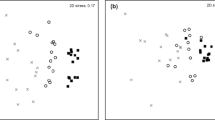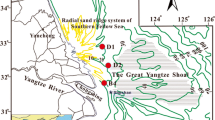Abstract
Meiofauna are eroded from sediments and transported in the water column. To examine how meiofauna respond to erosive currents, in situ current speeds were altered on an intertidal sandflat located in Bogue Sound, North Carolina, USA in July 1982. Replicates of two different weir designs were erected. One design increased measured current speed and the other, a control, did not. The depth distributions of meiofauna in each treatment and from undisturbed sediment were compared. There were few differences among treatments in depth distribution of the most abundant taxa: nematodes, turbellarians, and ciliates (>37-μm-long). However, a significant amount of sediment erosion (a mean of almost 0.5 cm in 2 h) occured in the increased flow treatment. Meiofauna responded to the loss of sediment with no discernable differences in depth distribution relative to the controls. There was some evidence that nematodes were less abundant and ciliates more abundant in the top 0.5 cm of the increased flow treatment. This may indicate that nematodes respond to fast surface current speeds by moving deeper into the sediments, while ciliates manage to remain near the surface even as sediment erodes. The entrainment of meiofauna may be passive but meiofauna clearly exert considerable behavioral influence over their susceptibility to entrainment.
Similar content being viewed by others
Literature cited
Bell, S. S. and K. M. Sherman: A field investigation of meiofaunal dispersal: tidal resuspension and implications. Mar. Ecol. Prog. Ser. 3, 245–249 (1980)
Boaden, P. J. S.: Water movement — a dominant factor in interstitial ecology. Sarsia 34, 125–136 (1968)
Boaden, P. J. S.: The behavior of Monocelis lineata (Muller, Turbellaria Otoplanidae) in a false otoplanid-zone. Acta Zool. Fenn. 154, 37–46 (1977)
Boaden, P. J. S. and D. G. Erwin: Turbanella hyalina versus Protodriloides symbioticus: a study in interstitial ecology. Vie Milieu suppl. 22, 479–492 (1971)
Boaden, P. J. S. and H. M. Platt: Daily migration patterns in an intertidal meiobenthic community. Thalassia jugosl. 7, 1–12 (1971)
Borror, A. C.: Ecology of interstitial ciliates. Trans. Am. microsc. Soc. 87, 233–243 (1968)
Brett, C. E.: Relationships between marine invertebrate infauna distribution and sediment type distribution in Bogue Sound, N.C. Ph.D. dissertation, University of North Carolina, Chapel Hill 1963
Cohen, J.: Statistical power analysis for the behavioral sciences, 474 pp. 2nd ed. New York: Academic Press 1977
Crenshaw, D. G.: How interstitial animals deal with viscous flows. Ph.D. dissertation, Duke University 1980
deJonge, V. N. and L. A. Bouwman: A simple density separation technique for quantitative isolation of meiobenthos using colloidal silica LUDOX-AM. Mar. Biol. 42, 143–148 (1977)
Eckman, J. E., A. R. M. Nowell and P. A. Jumars. Sediment destabilization by animal tubes. J. mar. Res. 39, 361–374 (1981)
Fegley, S. R.: Experimental studies on the erosion of meiofauna from soft-substrates by currents and waves, 164 pp. Ph.D. dissertation, University of North Carolina, Chapel Hill 1985
Fleeger, J. W., G. T. Chandler, G. R. Fitzhugh and F. E. Phillips: Effects of tidal currents on meiofauna densities in vegetated salt marsh sediments. Mar. Ecol. Prog. Ser. 19, 49–53 (1984)
Gray, J. S.: The behavior of Protodrilus symbioticus (Giard) in temperature gradients. J. Anim. Ecol. 34, 455–461 (1965)
Gray, J. S.: An experimental approach to the ecology of the harpacticoid Leptastacus constrictus Lang. J. exp. mar Biol. Ecol. 2, 278–292 (1968)
Hagerman, G. H. and R. M. Rieger: Dispersal of benthic meiofauna by wave and current action in Bogue Sound, North Carolina, USA. P.S.Z.N.I.: Mar. Ecol. 2, 245–270 (1980)
Jansson, B. O.: Diurnal and annual variation of temperature and salinity of interstitial water in sandy beaches. J. exp. mar. Biol. Ecol. 1, 123–143 (1967)
Joint, I. R., J. M. Gee and R. M. Warwick: Determination of finescale vertical distribution of microbes and meiofauna in an intertidal sediment. Mar. Biol. 72, 157–164 (1982)
Jumars, P. A. and A. R. M. Nowell: Fluid and sediment dynamic effects on marine benthic community structure. Am. Zool. 24, 45–55 (1984)
Kleinbaum, D. G. and L. L. Kupper: Applied regression analysis and other multivariable methods, 556 pp. North Scituate, MA: Duxbury Press (1978)
McLachlan, A.: A quantitative analysis of the meiofauna and the chemistry of the redox potential discontinuity zone in a sheltered sandy beach. Estuar. cstl mar. Sci. 7, 275–290 (1978)
Ott, J.: Determination of fauna boundaries of nematodes in an intertidal sand flat. Int. Revue ges. Hydrobiol. 57, 645–663 (1972)
Palmer, J. P. and T. E. Round: Persistent vertical migration rhythms in benthic microflora. VI. The tidal and diurnal nature of the rhythm in the diatom Huntzschia virgata. Biol. Bull. mar. biol. Lab., Woods Hole 132, 44–55 (1967)
Palmer, M. P.: Invertebrate drift: behavioral experiments with intertidal meiobenthos. Mar. behav. Physiol. 10, 235–253 (1984)
Palmer, M. P. and R. R. Brandt: Tidal variation in sediment densities of marine benthic copepods. Mar. Ecol. Prog. Ser. 4, 207–212 (1981)
Palmer, M. P. and G. Gust: Dispersal of meiofauna in a turbulent tidal creek. J. mar. Res. 43, 179–210 (1985)
Peterson, C. H.: Clam predation by whelks (Busycon spp.): experimental tests of the importance of prey size, prey density, and seagrass cover. Mar. Biol. 66, 159–170 (1982)
Platt, H. M.: Vertical and horizontal distribution of free-living marine nematodes from Strangford Lough, Northern Ireland. Cah. Biol. mar. 18, 261–273 (1977)
Reise, K. and P. Ax: A meiofaunal “thiobios” limited to the anaerobic sulfide system of marine sand does not exist. Mar. Biol. 54, 225–237 (1979)
Riedl, R. J. and R. Machan: Hydrodynamic patterns in lotic intertidal sands and their bioclimatological implications. Mar. Biol. 13, 179–209 (1972)
Rieger, R. M. and J. Ott: Gezeitbedingte Wanderungen von Turbellarian und Nematoden eines nordadriatischen Sandstrandes. Vie Milieu suppl. 22, 425–447 (1971)
Sutherland, J. P. and R. H. Karlson: Development and stability of the fouling community at Beaufort, North Carolina. Ecol. Monogr. 47, 425–446 (1977)
Swedmark, B.: The interstitial fauna of marine sand. Biol. Rev. 39, 1–42 (1964)
Taylor, W. R.: Light and photosynthesis in interstitial benthic diatoms. Helgoländer wiss. Meeresunters. 10, 29–37 (1964)
Toft, C. A. and P. J. Shea: Detecting community-wide patterns: estimating power strengthens statistical inference. Am. Nat. 122, 618–625 (1983)
Vogel, S.: Life in moving fluids, 352 pp. Boston, MA: Willard Grant Press 1981
Wallace, H. R.: The dynamics of nematode movement. A. Rev. Phytopathol. 6, 91–114 (1968)
Wieser, W.: The meiofauna as a tool in the study of habitat heterogeneity: ecophysiological aspects. A review. Cah. Biol. mar. 16, 647–670 (1975)
Author information
Authors and Affiliations
Additional information
Communicated by J. P. Grassle, Woods Hole
Rights and permissions
About this article
Cite this article
Fegley, S.R. Experimental variation of near-bottom current speeds and its effects on depth distribution of sand-living meiofauna. Mar. Biol. 95, 183–191 (1987). https://doi.org/10.1007/BF00409004
Accepted:
Issue Date:
DOI: https://doi.org/10.1007/BF00409004




